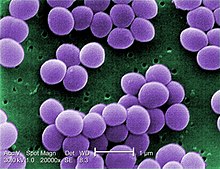Pus consists of a thin, protein-rich fluid, known as liquor puris, and dead leukocytes from the body's immune response (mostly neutrophils). During infection, macrophages release cytokines which trigger neutrophils to seek the site of infection by chemotaxis. There, the neutrophils engulf and destroy the bacteria and the bacteria resist the immune response by releasing toxins called leukocidins.[2] As the neutrophils die off from toxins and old age, they are destroyed by macrophages, forming the viscous pus.
Bacteria that cause pus are called suppurative, pyogenic,[2][3] or purulent. If the agent also creates mucus, it is called mucopurulent. Purulent infections can be treated with an antiseptic.
Despite normally being of a whitish-yellow hue, changes in the color of pus can be observed under certain circumstances. Pus is sometimes green because of the presence of myeloperoxidase, an intensely green antibacterial protein produced by some types of white blood cells. Green, foul-smelling pus is found in certain infections of Pseudomonas aeruginosa. The greenish color is a result of the pyocyanin bacterial pigment it produces. Amoebic abscesses of the liver produce brownish pus, which is described as looking like "anchovy paste". Pus can also have a foul odor.
In almost all cases when there is a collection of pus in the body, the clinician will try to create an opening for it to evacuate - this principle has been distilled into the famous Latin aphorism "Ubi pus, ibi evacua!"
Some common disease processes caused by pyogenic infections are impetigo, osteomyelitis, septic arthritis, and necrotizing fasciitis.[4][not in citation given]
Pyogenic bacteria
A great many species of bacteria may be pyogenic. The most commonly found include:[5][unreliable medical source?]- Staphylococcus aureus
- Staphylococcus epidermidis
- Streptococcus pyogenes
- Escherichia coli (Bacillus coli communis)
- Streptococcus pneumoniae (Fraenkel's pneumococcus)
- Klebsiella pneumoniae (Friedländer's bacillus)
- Salmonella typhi (Bacillus typhosus)
- Pseudomonas aeruginosa
- Neisseria gonorrhoeae
- Actinomyces
- Burkholderia mallei (Glanders bacillus)
- Mycobacterium tuberculosis (tubercle bacillus)
Exudate
From Wikipedia, the free encyclopedia
In humans, exudate can be a pus-like or clear fluid. When an injury occurs, leaving skin exposed, it leaks out of the blood vessels and into nearby tissues. The fluid is composed of serum, fibrin, and white blood cells. Exudate may ooze from cuts or from areas of infection or inflammation.[2]
Inflammation
From Wikipedia, the free encyclopedia
Progressive destruction of the tissue would compromise the survival of the organism. However, chronic inflammation can also lead to a host of diseases, such as hay fever, periodontitis, atherosclerosis, rheumatoid arthritis, and even cancer (e.g., gallbladder carcinoma). It is for that reason that inflammation is normally closely regulated by the body.
Inflammation can be classified as either acute or chronic. Acute inflammation is the initial response of the body to harmful stimuli and is achieved by the increased movement of plasma and leukocytes (especially granulocytes) from the blood into the injured tissues. A cascade of biochemical events propagates and matures the inflammatory response, involving the local vascular system, the immune system, and various cells within the injured tissue. Prolonged inflammation, known as chronic inflammation, leads to a progressive shift in the type of cells present at the site of inflammation and is characterized by simultaneous destruction and healing of the tissue from the inflammatory process.
Staphylococcus aureus
From Wikipedia, the free encyclopedia
| Staphylococcus aureus | |
|---|---|
 |
|
| Scanning electron micrograph of S. aureus; false color added. | |
| Scientific classification | |
| Domain: | Bacteria |
| Kingdom: | Eubacteria |
| Phylum: | Firmicutes |
| Class: | Bacilli |
| Order: | Bacillales |
| Family: | Staphylococcaceae |
| Genus: | Staphylococcus |
| Species: | S. aureus |
| Binomial name | |
| Staphylococcus aureus Rosenbach 1884 |
|
Staphylococcus was first identified in Aberdeen, Scotland (1880) by the surgeon Sir Alexander Ogston in pus from a surgical abscess in a knee joint.[1] This name was later appended to Staphylococcus aureus by Rosenbach who was credited by the official system of nomenclature at the time. It is estimated that 20% of the human population are long-term carriers of S. aureus[2] which can be found as part of the normal skin flora and in anterior nares of the nasal passages.[2][3] S. aureus is the most common species of staphylococcus to cause Staph infections and is a successful pathogen due to a combination of nasal carriage and bacterial immuno-evasive strategies.[2][3] S. aureus can cause a range of illnesses, from minor skin infections, such as pimples, impetigo, boils (furuncles), cellulitis folliculitis, carbuncles, scalded skin syndrome, and abscesses, to life-threatening diseases such as pneumonia, meningitis, osteomyelitis, endocarditis, toxic shock syndrome (TSS), bacteremia, and sepsis. Its incidence ranges from skin, soft tissue, respiratory, bone, joint, endovascular to wound infections. It is still one of the five most common causes of nosocomial infections and is often the cause of postsurgical wound infections. Each year, some 500,000 patients in American hospitals contract a staphylococcal infection.[4]


No comments:
Post a Comment